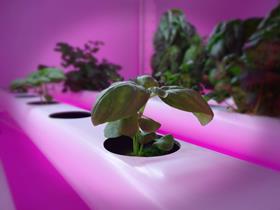
Having converted an old bomb shelter 33 metres under London into a successful fresh produce business, Growing Underground’s co-founder Steven Dring has a few reasons to feel cheerful. “I don’t want to sound arrogant, but we’ve created a new category,” he opines. Furthermore he’s part of a rising trend of micro produce growers, often based in urban grow operations, popping up to tap into what could be called a micro revolution.
Not too long ago, micro produce was the green bits in your egg mayonnaise sandwich. Nowadays you’re more likely to find it delicately balanced on top of some high-end nosh. The gamut of micro produce is in fact large, ranging from micro herbs to shrunken staples such as beetroot and carrots. The category is dominated by leafy salad greens, however, which offer a panoply of surprising flavours from oyster to liquorice.
The foodservice sector has championed their wide repertoire for a while, with restaurants and caterers taking advantage of micro produce’s unique flavour range. As a category, it’s yet to find a place in the average shopper’s consciousness, yet there are early signs that it may one day develop into an established ingredient.
“There’s a demand from retail, but even a small demand for us is huge,” says Dring. “When we came into the market in 2014, it was a small but growing scene, but it just got bigger and bigger, and volumes got bigger and bigger. We moved from Michelin-starred chefs down through catering into retail, and it’s going to keep going into retail.”
Few epitomise this rapid innovation better than Rob Baan’s Dutch company Koppert Cress. Sometimes dubbed the “Willy Wonka” of micro produce, Baan’s company turns out creations that could pass for something endemic to Loompaland: ‘mini-watermelons’, Floregano and oyster leaves to name a few.
Koppert’s Paul Da Costa Greaves reels off a few of their best-selling oddities that sound at home in a Homeric epic: “Our double-headed Jasmine Blossom is extremely fragrant all year round. There’s also the quirky From Age Leaves, tasting of baked camembert, adding that twist to the cheese-free-cheese burger, and our juicy Majii Leaves, which chefs and bartenders are injecting to surprise their guests.”
With such a range of novel flavours, the innovative and fun flair of micro produce fits in well with modern work spaces too, some of which have large catering budgets. “We had the head of global dining from Microsoft look round recently,” Dring recalls.
Jamie Burrows, founder of urban health start-up Vertical Future, with its main activities in vertical farming, supplies foodservice companies including salad chain Chop’d and Michelin star chef Tom Aikens, believes that the health benefits of micro produce are ideally adapted to current health trends too. “There’s a demand out there for what we do. We focus on working directly with restaurants and through our customisable subscription boxes for healthy eaters at home.” Vertical Future’s consumer-facing brand Minicrops produces over 60 varieties of sustainable micro produce, grown indoors, minutes from central London.
But can this innovation trickle down into the kitchen of the “man on the Clapham omnibus?” When supermarkets stock entire shelves of Irish cakes, a similar space devoted to micro produce doesn’t seem unreasonable.
“It’s not far off, it’s just a question when, 12 months or 24 months, we don’t know. We haven’t developed single variety packs yet as we don’t want to contribute to food waste,” says Dring.
Craig Thomas, commercial manager of CN seeds adds: “Retail is still a tough one to crack as microgreens are seen as a high-end garnish, although they do offer great nutrition and flavour. The shopper doesn’t think to pick up a microgreen pack even if they are making a special meal for guests at home; the catering industry and restaurants still lead the way.”
Burrows says that for urban growing operations like his own price can be an issue for retailers. “We do see long-term potential with supermarkets but prefer working with restaurants and homes. This approach offers more room for creativity and will also help to pave the way for a more established and long-term presence for micro greens in supermarkets.”
Showing consumers how micro produce can be used is key to driving retail growth in the category, and Growing Underground plans to include cooking tips on future packaging. “You can start to show people how to put a bit on top of their scrambled eggs,” he says. “We’re looking at how to drive it through social media, showing people they can do this and that with each product.”
Burrows adds: “I don’t think urban farming will be a long-term replacement of all agriculture, but it will be a long-term, complementary approach to traditional farming and will not only find its feet in cities, but elsewhere also.”
The rise of micro produce feels like the beginning of something new, something that retailers will surely tap into. Their range and playfulness make them well suited to modern tastes and to top it off, it’s hyper-local produce with a cool factor. But whatever its future, they’ve already come a long way from egg-mayo sarnies.
Pick of the Bunch: Up-and-coming micro produce
Red Amaranth
One of the brightest micro leafs, Red Amaranth is high in vitamins A, C and E, as well as iron, magnesium, phosphor, potassium, calcium and antioxidants.
Floregano
These small flowers, which go by a brand name chosen by Koppert, taste like oregano, look like roses, and originate in the Mediterranean.
Wasabina Mustard
Despite looking like clover, the wasabina mustard leaf packs a spicy kick, although is not actually grown from the wasabi root.
Pepquiño
Sometimes called ‘mini watermelons’, this unusual fruit sold by Koppert tastes like sour cucumber. The company describes it as an ancient species that most likely originates in South America.



